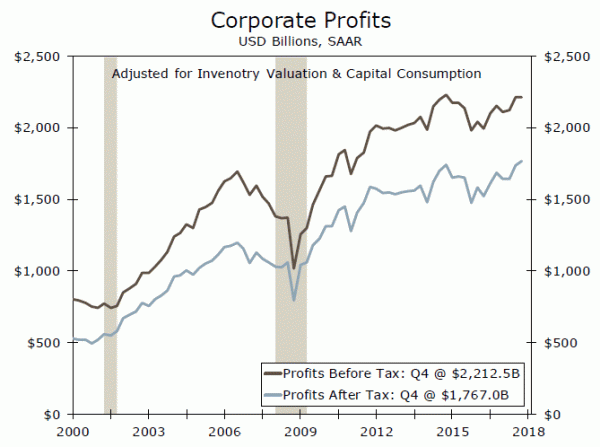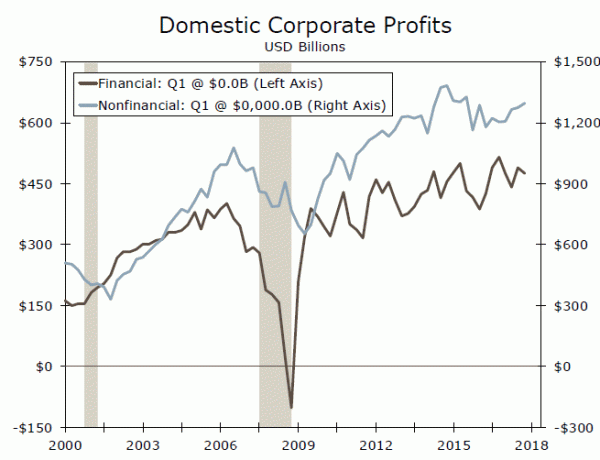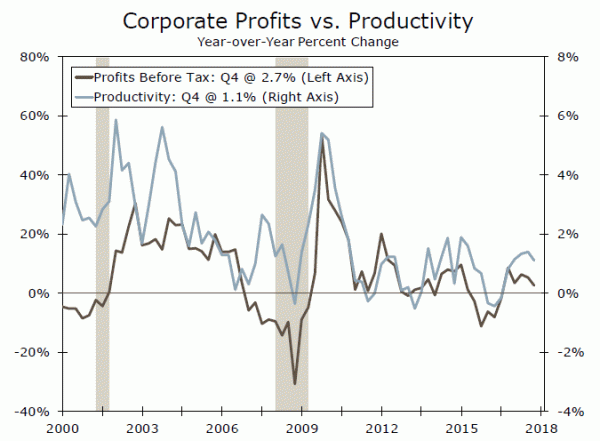The anticipation of tax-reform could have influenced fourth quarter profits. Tax reform will likely lead accelerated profit growth in the year ahead, even as pre-tax profit growth remains muted.
The Tricky Effects of Tax Cuts
The third release of fourth quarter GDP not only revised overall growth up to 2.9 percent from 2.5 percent, but also revealed the possible start of the effects of corporate tax reform on corporate profit growth. Pre-tax corporate profits decreased $1.1 billion in the fourth quarter, compared to an increase of $90.2 billion in the third quarter. However, taxes paid on corporate income decreased roughly $30 billion over the quarter, resulting in continued growth in after-tax corporate profits.
The slight slowdown in pre-tax profit growth is consistent with what we would expect to see at this late stage of the current expansion. However, were corporate tax cuts evident in fourth quarter profits? The newly enacted 2017 Tax Cuts and Jobs Act (which went into effect on January 1, 2018) cut the top statutory corporate tax rate to 21 percent from 35 percent, while revising several corporate deductions and exclusions. In anticipation of tax cuts, it is possible that firms delayed the realization of profits until the first quarter. However, although changes to the expensing of bonus depreciation and the one-time repatriation tax went into effect in the fourth quarter, such revisions do not alter the National Income and Production Accounts (NIPA) measure of corporate profits (which are defined as profits from current production). We do highlight that the statutory corporate tax rate (Q4 = 35 percent) differs significantly from the effective corporate tax rate (Q4 = 20 percent), or the rate a corporation actually faces after accounting for available deductions and exclusions present in the tax code.
We anticipate as the newly enacted tax rate drives the effective rate lower, it will directly boost after tax profit growth in the year ahead. The effects of the remaining tax modifications (deductions and exclusions) will likely alter profit growth for individual firms; however, due to calculation methods, such modifications will not show up in the NIPA measure of corporate profits.
Nonfinancial Domestic Profits likely to Continue to Lead Growth
For the fourth quarter, domestic profits rose $4.8 billion, while foreign profits fell $5.9 billion. As domestic profits encompass roughly 80 percent of total profits, we emphasize the increase in Q4. Led by nonfinancial corporate profits, (which accelerated $19.4 billion) domestic profits appear well positioned to possibly surpass their previous peak seen in the current expansion. Profits in the financial sector, however, decreased $14.6 billion.
For the year as a whole, corporate profits rose $91.2 billion. While we predict the lower statutory corporate tax rate will modestly boost after-tax corporate profit growth in 2018, we continue to expect trend-like growth for our current forecast horizon. On average over the past five years, productivity rose only 0.8 percent per year, while unit labor costs have increased 1.3 percent. With low productivity and increasing labor costs, coupled with the rising interest rate environment that exists today, fundamentals alone do not appear supportive of a continued acceleration in profit growth.
















